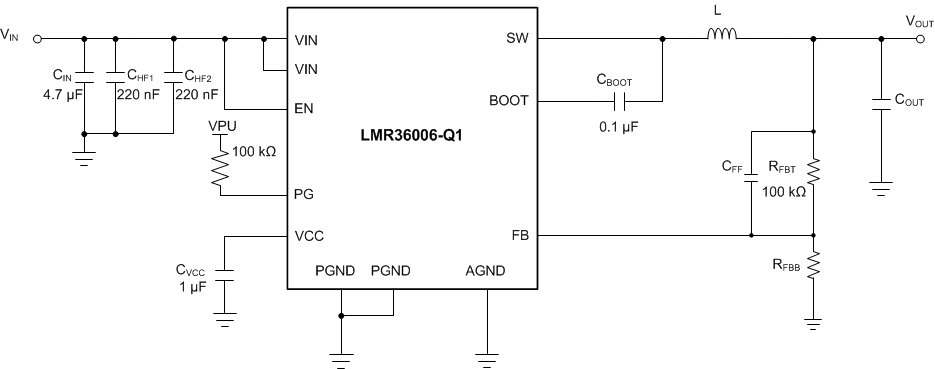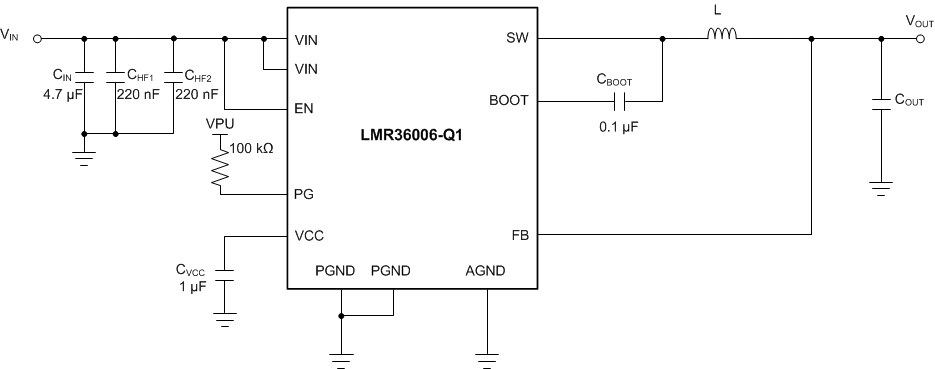JAJSFY3D August 2018 – August 2022 LMR36006-Q1
PRODUCTION DATA
- 1 特長
- 2 アプリケーション
- 3 概要
- 4 Revision History
- 5 Device Comparison Table
- 6 Pin Configuration and Functions
- 7 Specifications
- 8 Detailed Description
-
9 Application and Implementation
- 9.1 Application Information
- 9.2
Typical Application
- 9.2.1
Design 1: Low Power 24-V, 600-mA PFM Converter
- 9.2.1.1 Design Requirements
- 9.2.1.2
Detailed Design Procedure
- 9.2.1.2.1 Custom Design With WEBENCH Tools
- 9.2.1.2.2 Choosing the Switching Frequency
- 9.2.1.2.3 Setting the Output Voltage
- 9.2.1.2.4 Inductor Selection
- 9.2.1.2.5 Output Capacitor Selection
- 9.2.1.2.6 Input Capacitor Selection
- 9.2.1.2.7 CBOOT
- 9.2.1.2.8 VCC
- 9.2.1.2.9 CFF Selection
- 9.2.1.2.10 Maximum Ambient Temperature
- 9.2.1.3 Application Curves
- 9.2.2 Design 2: High Density 12-V , 600-mA FPWM Converter
- 9.2.1
Design 1: Low Power 24-V, 600-mA PFM Converter
- 9.3 What to Do and What Not to Do
- 10Power Supply Recommendations
- 11Layout
- 12Device and Documentation Support
- 13Mechanical, Packaging, and Orderable Information
パッケージ・オプション
メカニカル・データ(パッケージ|ピン)
- RNX|12
サーマルパッド・メカニカル・データ
- RNX|12
発注情報
9.2 Typical Application
Figure 9-1 and Figure 9-2 show typical application circuits for the LMR36006-Q1. This device is designed to function over a wide range of external components and system parameters. However, the internal compensation is optimized for a certain range of external inductance and output capacitance. As a quick start guide, Table 9-1 provides typical component values for a range of the most common output voltages.
 Figure 9-1 Example Applications Circuit (Adjustable Output)
Figure 9-1 Example Applications Circuit (Adjustable Output) Figure 9-2 Example Applications Circuit (Fixed 3.3 V Output)
Figure 9-2 Example Applications Circuit (Fixed 3.3 V Output)Table 9-1 Typical External Component Values
| ƒSW (kHz) | VOUT (V) | L (µH) | NOMINAL COUT (RATED CAPACITANCE) (1) | MINIMUM COUT (RATED CAPACITANCE) (2) | RFBT (Ω) | RFBB (Ω) | CIN | CFF |
|---|---|---|---|---|---|---|---|---|
| 400 | 3.3 | 22 | 2 × 22µF | 1 × 22µF | 100 k | 43.2 k | 4.7 µF + 2 × 220 nF | 20 pF |
| 2100 | 3.3 | 6.8 | 2 × 15 µF | 1 × 15 µF | 100 k | 43.2 k | 4.7 µF + 2 × 220 nF | 20 pF |
| 400 | 5 | 33 | 2 × 22 µF | 1 × 22 µF | 100 k | 24.9 k | 4.7 µF + 2 × 220 nF | 20 pF |
| 2100 | 5 | 10 | 2 × 15 µF | 1 × 15 µF | 100 k | 24.9 k | 4.7 µF + 2 × 220 nF | 20 pF |
| 400 | 12 | 56 | 2 × 22 µF | 1 × 22 µF | 100 k | 9.09 k | 4.7 µF + 2 × 220 nF | 20 pF |
| 2100 | 12 | 22 | 2 × 15 µF | 1 × 15 µF | 100 k | 9.09 k | 4.7 µF + 2 × 220 nF | 20 pF |
(1) Optimized for superior load transient performance from 0 to 100% rated load.
(2) Optimized for size constrained end applications.